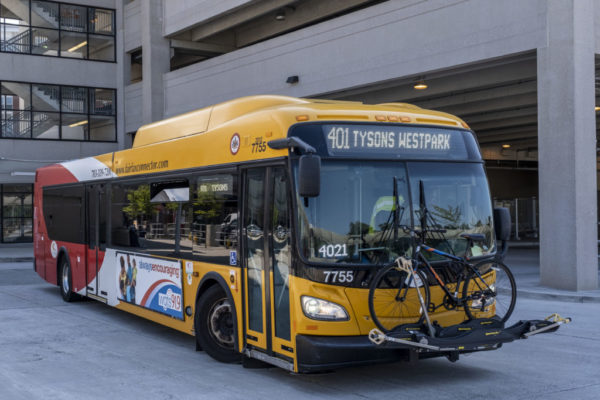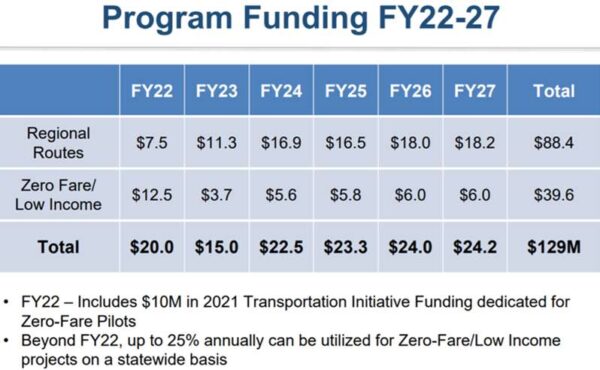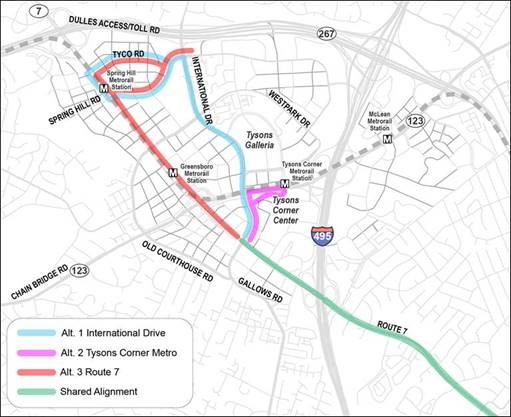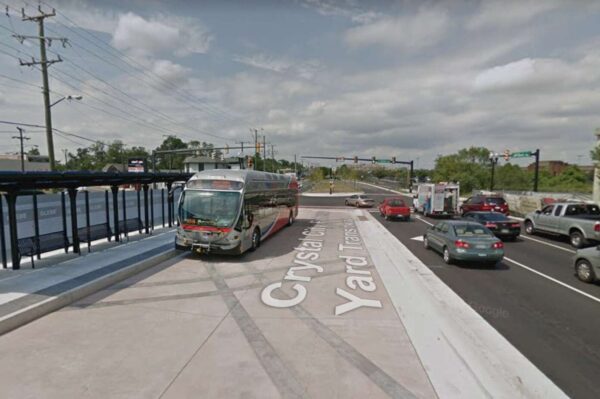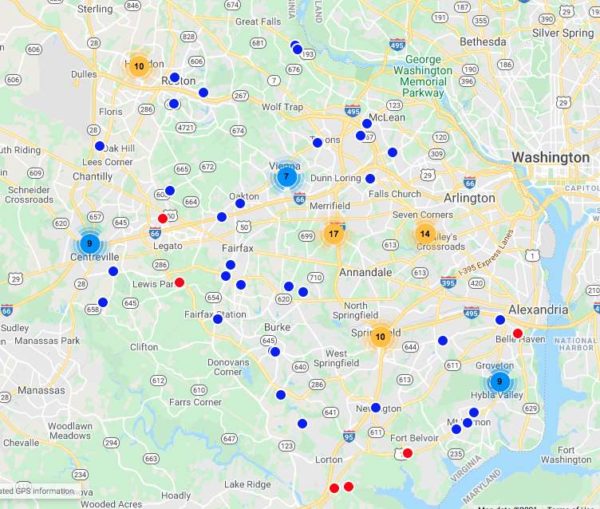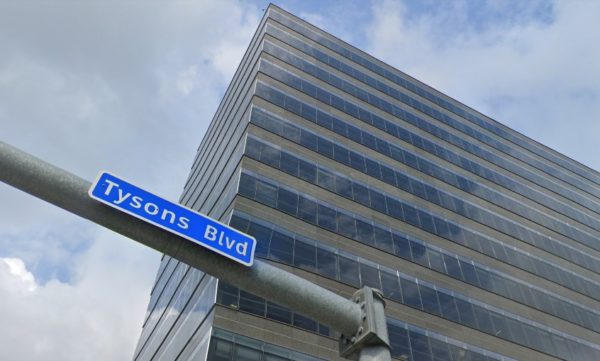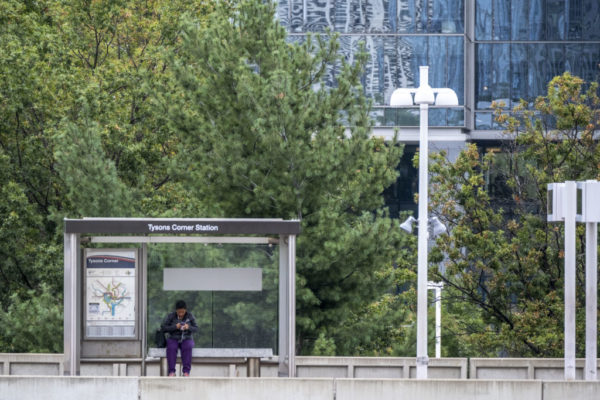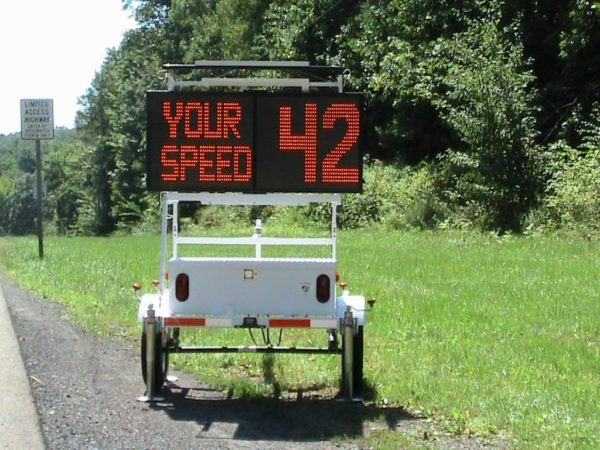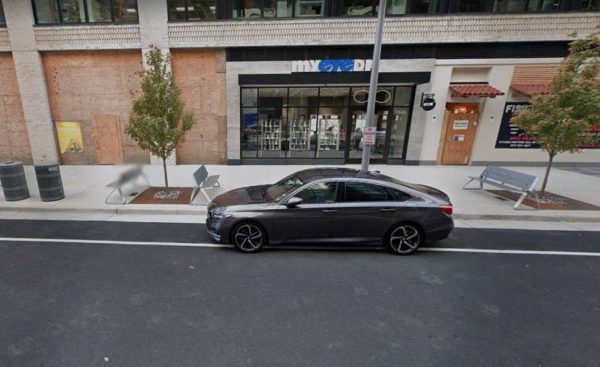
Updated at 3:55 p.m. Fairfax County is seeking public feedback about people’s parking habits and priorities in Tysons and Reston with a survey available now in English and Spanish until the end of July.
County staff are using the online survey to help establish a managed parking program in the Tysons Urban Center and Reston Transit Station Areas, which they hope will address issues ranging from limited parking options to avoiding vehicles reportedly remaining in spaces for weeks at a time.
Fairfax County currently has no paid on-street parking meters and collects no money in on-street parking revenue. Parking meters are on private streets, the county notes.
In addition to asking about people’s current parking habits, the survey tells respondents to prioritize five factors that affect when and where they decide to park:
- Lowest price or free
- Proximity of parking to desired location
- Flexible payment options (credit cards, smartphone apps)
- Ability to pay with cash
- Overnight parking is allowed for free
The county is looking to get input from both commuters and residents. In addition to filling out the survey, community members can submit comments through an online feedback form, by mail to the Fairfax County Department of Transportation, and by calling 703-877-5600.
The survey will build on the results of a two-year study that FCDOT conducted to look at the availability of on-street parking on state-owned roads in Tysons and Reston.
In Tysons, the study found 1,272 on-street parking spaces along 22 miles of curb, amounting to 29% of the available space. Recommendations included implementing timed or paid parking near Metro stations to encourage turnover and addressing issues with commercial vehicles parking in front of businesses.
The county is looking to support businesses with “shorter duration parking and parking space turnover,” according to a page about the survey.
“Ultimately, the goal is to provide parking that supports the mixed-use development in these increasingly-urban areas of the County,” FCDOT said in a news release.
County staff is slated to use the information from the survey to propose policy and ordinance changes to the Board of Supervisors next year. FCDOT says the managed parking plans will mostly not take effect until new grids of streets are built in Tysons and Reston and accepted by the Virginia Department of Transportation.
Correction: This article has been updated to show when county staff expect to recommend ordinance changes.
via Google Maps
Fairfax Connector suspended fare collections last year as a temporary health measure in response to the COVID-19 pandemic, but the public bus system is considering longer-term adjustments to its fare policies with support from a new state grant program.
The Fairfax County Department of Transportation is one of 12 transit agencies in Virginia that have expressed interest in the Department of Rail and Public Transportation’s new Transit Ridership Incentive Program (TRIP), which will fund projects that increase connectivity in highly populated areas or remove barriers for low-income individuals by reducing or eliminating fares.
While fare collection resumed on Jan. 4, county leaders see reducing or subsidizing trip costs as one way to encourage more people to ride the Connector, which is the largest local bus system in Northern Virginia, transporting approximately 30,000 passengers on 91 routes in ordinary times.
“Access to transit is crucial in promoting equity county-wide and for many a barrier is cost,” Fairfax County Board of Supervisors Jeff McKay said. “Our Department of Transportation is committed to looking into how we can provide aid to those experiencing economic hardship.”
Created by the General Assembly during its 2020 session, TRIP was conceived before the novel coronavirus arrived in the U.S., but Virginia Transportation Secretary Shannon Valentine told the Commonwealth Transportation Board during a May 18 workshop that the pandemic illustrated how vital public transportation is for essential workers, DCist reported.
“Fares turned out to be an obstacle. So we are really trying to use this as an opportunity,” Valentine said, according to DCist.
DRPT has split TRIP into two programs: one focused on regional connectivity, which could include everything from integrated fare collection systems to the creation of bus-only lanes on significant routes, and one focused on reducing the impact of fares on low-income users, which could involve eliminating fares, creating zero-fare zones, or providing subsidized or free passes.
Virginia has allocated a total of $129 million to the TRIP initiative through fiscal year 2027, including $88.4 million for the connectivity program and $39.6 million for the fare program, according to a presentation that DRPT delivered to the Commonwealth Transportation Board.
Legislators limited the fare reduction program to 25% of the initiative’s annual funding, but the General Assembly gave the program an additional $10 million in the state’s fiscal year 2022 budget, raising its total to $12.5 million for the upcoming fiscal year, which begins on July 1.
DRPT released a draft policy last week outlining how TRIP will be implemented, including how projects will be evaluated for grant funds. The resolution is open for public input through June 18, and the CTB is scheduled to vote on it on June 23.
The department has also made a draft of the program’s application guidelines available for public comment until July 7. Read More
People who live and work in Tysons are one step closer to getting a bus rapid transit route through the area.
Fairfax County began studying options for bus rapid transit in Tysons two-and-a-half years ago as part of the larger Envision Route 7 BRT project from the Northern Virginia Transportation Commission, which would establish bus service between Tysons and the Mark Center in Alexandria.
Now, the Fairfax County Department of Transportation has settled on a preferred route within Tysons, which it will recommend to the NVTC as the organization embarks on the fourth phase of study for the Envision project.
The county’s preferred route goes up Route 7 and takes International Drive up to Spring Hill Road, where it loops onto Tyco Road to rejoin International Drive. It will make six stops, FCDOT BRT Route 7 Project Manager Sean Schweitzer said during an informational meeting Wednesday night (March 24).
FCDOT chose the route out of three proposed alternatives because it would serve the most households, the greatest population — about 6,700 people — and the largest employment area in Tysons, according to Schweitzer.
Staff had narrowed nine options down to three after considering cost, sustainability, and accessibility, among other factors, he said. The second option, which is much shorter, branches off Route 7 to loop past Tysons Corner Center and the Tysons Metro station.
Schweitzer said the third alternative most closely resembles the NVTC’s vision for a route through Tysons, circling around Tyco and Spring Hill roads but remaining aligned with Route 7 by passing through the Greensboro Metro station.
FCDOT staff will accept comments on the proposed paths through April 14 via the Route 7 BRT Survey. The NVTC will incorporate the selected route into the final phase of its Envision Route 7 BRT study this summer and fall, Schweitzer said.
“BRT is a more efficient form of local bus, which typically operates in zone-exclusive lanes,” he said. “BRT usually has enhanced stations with raised platforms for level boarding, smart digital fare, and real-time passenger information and bus times. Stops are more limited than local bus and are more distanced.”
BRT is comparable to light rail but at a lower capital cost, he said.
Like the BRT service operated by the Washington Metropolitan Area Transit Authority in Alexandria, pictured above, a service in Tysons could run along the median for part of the route. To further reduce conflicts with cars and bicycles, buses would get transit signal priority, and bicycle lanes would run behind the stations.
The buses would drive in mixed traffic, turning left onto Spring Hill and transitioning into a bus-and-turn lane before returning to the median lane, according to Schweitzer.
The service would run from 5 a.m. to 1 a.m. on weekdays and 6 a.m. to 12 a.m. on weekends, seating 110 passengers, he said.
After the meeting, FCDOT planner Mike Garcia told Tysons Reporter that the county obtained input from residential and commercial management groups, homeowners and civic associations, faith communities, libraries, recreational centers, schools, and other stakeholders, including the Tysons Partnership, in coordination with district supervisor offices.
“The pandemic did limit our outreach efforts to physically reach out to communities,” he said.
Map via FCDOT, photo via Google Maps
The Fairfax County Department of Transportation (FCDOT) has developed three potential routes for a bus rapid transit system (BRT) that would travel through Tysons and along the Route 7 corridor.
County staff will hold virtual public meetings at noon on Friday (March 19) and at 7 p.m. next Wednesday (March 24) to share details about the proposed routes, including possible station locations and performance analyses based on tests of the options.
Fairfax County has been studying options for bus rapid transit in Tysons since October 2018 as an offshoot of a larger Northern Virginia Transportation Commission Envision Route 7 BRT project that would establish bus service between Tysons and the Mark Center in Alexandria through Falls Church.
The Fairfax County Board of Supervisors recently approved $140,000 in funding to support the next phase of NVTC’s study, which will evaluate mobility benefits, impacts, and potential issues that could arise from the proposed bus system.
The county’s Route 7 BRT study focuses specifically on the Tysons portion of the project, which encompasses approximately three miles of Leesburg Pike from the Spring Hill Metro station to the I-66 interchange.
Based on a map from FCDOT, the three routes currently being considered are:
- Alternative 1 circles around Tyco and Spring Hill roads via the Spring Hill Metro station and travels along International Drive before connecting with Route 7 at Gallows Road
- Alternative 2 branches off Route 7 to loop past Tysons Corner Center and the Tysons Metro station
- Alternative 3 circles around Tyco and Spring Hill roads but stays aligned with Route 7, passing through the Greensboro Metro station
FCDOT staff will present a preferred route out of those three options during the two upcoming public meetings, and there will be time for questions and provide feedback.
Attendees can register online to receive a link to the WebEx meetings or dial in by phone at 1-844-621-3956. Comments can also be provided through an electronic survey that will be available after the meetings or through the project team’s feedback form.
Comments on the Route 7 BRT study will be accepted until April 14.
Updated at 11:45 a.m. — The fatality and crash numbers in this article from the DMV reflect statistics for Northern Virginia, not just Fairfax County as previously stated. The Fairfax County Police Department says that the county’s fatality and crash rates are much lower.
With 38 pedestrian fatalities, 2019 was the deadliest year in the last decade to walk in Northern Virginia, according to Virginia DMV data.
The number of deaths dropped to 29 in 2020, but the Fairfax County Board of Supervisors and county transportation officials are still working on strategies to improve pedestrian and bicyclist safety with a countywide initiative.
“Unfortunately our incidents of pedestrian fatalities and crashes continue to be at unacceptable levels,” FCDOT bicycle and pedestrian program manager Chris Wells said during a transportation committee meeting yesterday (Tuesday). “Due to a number of factors, those numbers are trending up — not just in Fairfax, but in Virginia and across the United States.”
Bicycling is safer, but crash rates are still high: 216 crashes in 2019, and 157 in 2020.
Wells added that certain portions of Fairfax County’s population are disproportionately affected by pedestrian crashes, a trend that has been documented nationwide.
The county hopes to reverse these statistics. Wells told supervisors that FCDOT and VDOT have recently improved walking and cycling conditions by programming head starts into signals for pedestrians, re-striping four-lane roads as two-lane roads, and installing rapid-flashing beacons for crosswalks without lights.
VDOT awarded FCDOT $1.2 million last year to install nine more flashing beacons, bringing the county’s total to 17, Wells said.
VDOT also has a pedestrian safety action plan for improving safety along particularly dangerous corridors. In Fairfax County, the highest-priority roads are Columbia Pike, Little River Turnpike, Richmond Highway, Lee Highway, Lee-Jackson Memorial Highway, Braddock Road, and Ox Road.
Officials said that work on roads in Fairfax County is a lengthy process compared to other jurisdictions, because VDOT owns the roads.
“They’ve really stepped up this year to help us to advance pedestrian safety in a way that we have not seen in years past,” FCDOT Director Tom Biesiadny said.
Looking ahead, supervisors suggested introducing better lighting and longer crossing times at mid-block crosswalks. They are also still interested in reducing speeds in the county.
FCDOT officials said a multiagency group, including transportation officials and attorneys, is working through the logistics of speed cameras. Meanwhile, VDOT is preparing to examine where speed limits can be lowered.
Fairfax County has also been experimenting with closing street lanes to provide more room for walking and cycling. A pilot project that closed one lane on a half-mile section of Tysons Boulevard to motor vehicles ran from May 29 to Nov. 23 of last year, and a partial lane closure on Government Center Parkway has been in place since Aug. 31.
The Fairfax County Board of Supervisors gave the county’s transportation department permission this week to start work on plans for managed curbside parking in Tysons and Reston.
Whether the plan includes paid parking, time-limited parking, designated commercial vehicle parking, or some combination, the Fairfax County Department of Transportation will need at least a year to draw one up for the Board of Supervisors to review, staff said during a board transportation committee meeting on Tuesday.
The incremental step forward comes after professional traffic engineers released their findings from a two-year study that analyzed current parking habits in Tysons’ urban center and Reston’s transit station areas as well as potential options to manage parking.
“Currently in the county, we have a very limited toolbox of parking restrictions that can be implemented by either the Board or VDOT,” FCDOT Section Chief Neil Freschman said. “Generally, most on-street parking on public roadways is uncontrolled.”
The study found that public on-street parking in Reston is incredibly limited.
Parking is available on just 6% of the 15 miles of public curb space surrounding the Wiehle-Reston East, Reston Town Center, and Herndon Metrorail stations, FCDOT Senior Transportation Planner Henri Stein McCartney said.
“We found 211 total public on-street spaces within the study area, which is pretty low,” she said. “Most parking is on private streets, which we don’t manage.”
Comparatively, Tysons had more parking. Staff found 1,272 spaces along 22 miles — or 29% — of curb space on the roadways surrounding the Greensboro, Springhill, Tysons, and McLean Metro stations.
However, parking in Tysons suffers from other problems, including cars parked in “No Parking” zones and travel lanes, along with large commercial vehicles that overstay their welcome.
“Some of these vehicles are reportedly parking for days or weeks without moving,” McCartney said. “Our parking staff has received multiple complaints from Tysons businesses about commercial vehicles that are parking long-term near their building, so we know this is an issue.”
Transportation Committee Vice-Chair Kathy Smith, who represents Sully District, told Tysons Reporter that commercial vehicles parking for extended periods is a county-wide issue.
“I think it’s good that staff is looking into how to balance people’s ability to get into businesses and getting more turnover,” Smith said. “Everybody would agree you don’t want commercial vehicles taking up space for days.”
This parking plan is being developed alongside changes to the street grid in Tysons and Reston, Hunter Mill District Supervisor Walter Alcorn told Tysons Reporter. In some cases, parking policies will be developed for streets that do not yet exist, but have been incorporated into the two communities’ comprehensive plans to be more transit-oriented.
The management plan should encourage parking spot turnover to ensure that these future streets near transit stations, which are lined with mixed-use properties, do not become commuter lots, he said.
However, managed parking in Reston’s transit areas will have to overcome the controversy that Boston Properties ignited when the property manager introduced and later modified paid parking at the Reston Town Center.
“The number one lesson is, don’t make all your streets private,” Alcorn said. “We have an awful lot of private streets. What we’ve learned is that the public doesn’t have any say — it is up to the private street owner.”
While private streets make planning events more flexible, Alcorn says the 2017 flare-up, which focused mostly on the garage parking, could also be attributed in part to community members not having a say.
For the most part, though, what FCDOT is working on “is apples and oranges” compared to the RTC, he said.
Images via Google Maps, Fairfax County
People can provide feedback on Fairfax Connector’s proposed service changes for this fall, which include expanded service from the McLean Metro stop.
The Fairfax County Department of Transportation (FCDOT) is asking people to submit input via an online survey, email ([email protected]), phone (703-339-7200, TTY 703-339-1608) or mail, according to the county’s website.
“FCDOT normally conducts several community input meetings on proposed changes to Fairfax Connector service, but as a result of current public gathering restrictions due to COVID-19, transit staff recorded a presentation which is available online for viewing instead,” the website said.
The proposed service changes include several routes — the existing 334, 340/341 and 721 routes and the new 722, 350 and 351 routes.
More about the proposed changes to the Tysons-area routes:
Route 721: Chain Bridge Road – McLean Metrorail Station – Includes expanded weekday midday service every 30-minutes from the McLean Metrorail Station to the George Bush Center for Intelligence (GBCI) facility in Langley, Virginia. The buses will operate with 30-minute headways.
Route 722: McLean Metrorail Station – GBCI – Includes new weekday express service every 15 minutes during morning and afternoon peak hours between the McLean Metrorail Station and the GBCI facility in Langley.
People can submit comments until Friday, June 5. A presentation on the proposed changes on YouTube, the routes’ draft schedules and a PowerPoint presentation are available online.
FCDOT plans to present the final proposed changes to the county’s Board of Supervisors in July and, if the board approves them, the changes will go into effect by or before Oct. 31, the email said.
With sunnier and warmer days ahead, a portion of Tysons Blvd is poised to become a space for cyclists and pedestrians looking for more room to social distance.
Robin Geiger, a spokesperson for the Fairfax County Transportation Department (FCDOT), mentioned the plans during a town hall with county officials yesterday.
“We’re going to close a portion of Tysons Blvd to allow for safer biking and pedestrian access for exercise, to increase social distancing, so people can get around Tysons,” Geiger said.
The upcoming closure is part of a pilot project with Tysons Partnership, the Virginia Department of Transportation (VDOT) and the Fairfax Alliance for Better Bicycling, Geiger said. While Geiger did not say when the partial road closure is expected or which portion will be closed, she said that FCDOT will announce more information soon.
Providence District Supervisor Dalia Palchik praised the project, saying that “it does take quite a bit of coordination” for the county and VDOT to work on road projects.
“I’m just thrilled,” Palchik said.
Closing roads to give cyclists and pedestrians more space during the pandemic has been gaining traction around the U.S., WAMU reported.
“I know bikes are being sold quite a bit these days,” Palchik said, adding that “we take this opportunity to improve our bikeability and walkability.”
Image via Google Maps
(Updated 5/20/2020) Before Orange and Silver line stations temporarily close this Saturday (May 23), Fairfax County officials for the Tysons and Vienna areas want to know more about the closures’ impact.
Providence District Supervisor Dalia Palchik and Hunter Mill District Supervisor Walter Alcorn plan to hold a virtual town hall on Thursday (May 21), according to staff from Palchik’s office.
The discussion will include representatives from WMATA and the county’s transportation department.
All Orange and Silver line stations west of the Ballston station will be closed through the fall for platform reconstruction at the four Orange Line stations and work to connect the Silver Line with the upcoming stations running from Reston to Ashburn.
The town hall is set to start at 6:30 p.m. People can register online.
The Fairfax County supervisors representing Tysons and McLean voiced support for a proposed change that would allow residents to access roads with restricted turns during peak-hours.
Currently, a joint program from the transportation departments for Virginia and Fairfax County restricts access to neighborhood roads during peak-hour traffic — including the residents.
Fairfax County has three cut-thru restrictions in place. Four additional ones are at various stages, including:
- Dead Run Drive/Carper Street in McLean
- Electric Avenue/Williams Avenue/Overlook Street in the Tysons area
- Allen Avenue in the Falls Church area
Earlier this year, Virginia General Assembly passed a law allowing local jurisdictions to create a program to issue permits or stickers to residents to make turns into or out of a designated area during certain times of the day when those turns are not allowed.
Now, Fairfax County is considering creating the program with permits.
“Permits would not be available for visitors, caregivers, service providers, non-resident owners, relatives, or other non-residents,” according to a presentation to the Board of Supervisors today (Tuesday).
The Fairfax County Department of Transportation has submitted a budget request for fiscal year 2021 to pay for the change.
“We have not received any funding to pay for this,” Henri Stein McCartney, a transportation planner for FCDOT, told the board.
While the supervisors mostly agreed that cut-thru traffic is — as Lee District Supervisor Jeff McKay called it — a “bad problem” made worse by navigation software like Waze, they disagreed on whether or not to pursue the proposed change.
Chairman Sharon Bulova said that she is worried about not allowing people who need to get to the homes in the cut-thru area but aren’t residents.
Mason District Supervisor Penny Gross echoed Bulova’s concerns, saying that the program would create an “equity problem.”
“I don’t see anything that is broken here that needs to be fixed,” Gross said.
Gross also said that she does not support the “enormous” cost of the $230,000 software needed for the change.
Dranesville District Supervisor John Foust argued that residents should have access to the cut-thru areas, saying that the proposed change would allow more people in instead of keep more people out of the areas.
“Not being able to turn into your own neighborhood is what keeps neighborhoods from doing [the cut-thru program],” Providence District Supervisor Linda Smyth said. “We need to have some sort of selectivity here.”
Other supervisors, like McKay, voiced indecision on the proposal.
FCDOT now plans to work on a draft ordinance for a Board of Supervisors public hearing.
Photo via Facebook


